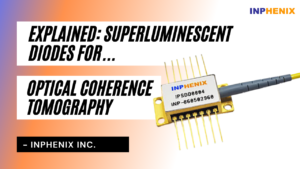
It is not uncommon to see the use of superluminescent diodes for optical coherence tomography. Because of the unique properties of superluminescent diodes (SLD), such as low coherence light, high brightness, minimal spectral ripple, and a broad, smooth optical output spectrum, it is the preferred and perfect solution for optical coherence tomography.
However, in order to comprehend why superluminescent diodes are used for optical coherence tomography, we must first understand what optical coherence tomography is, what a superluminescent diode is, what its properties are, and so on. So, let’s start with what a superluminescent diode is.

According to Wikipedia, a superluminescent diode (SLED or SLD) is an edge-emitting semiconductor light source based on superluminescence. It combines laser diodes’ high power and brightness with ordinary light-emitting diodes’ low coherence. In simpler terms, a superluminescent diode is a semiconductor device that emits low-coherence light with a broad spectrum, similar to that of a light-emitting diode but with high brightness, similar to that of a laser diode.
These diodes are appropriate for usage in Optical Coherence Tomography (OCT) imaging systems and fiber optic gyroscopes because they are high-power, broadband light sources.
Furthermore, typical superluminescent diodes for optical coherence tomography are built with a low gain ripple to generate two and three-dimensional cross-sectional micron-scale images of biological tissues within optical scattering environments.
Let’s now have a look at some of the most notable characteristics of superluminescent diodes.
The following are some of the significant characteristics of superluminescent diodes for optical coherence tomography:
1) SLDs are current-dependent devices. The quantity of optical power radiated by SLD is therefore proportional to the current. As a result, unlike laser diodes, SLDs do not have a sharp spike in intensity but instead increase gradually as the current increases.
2) SLD combines a laser diode’s output power and brightness with a broad LED-like visual spectrum.
3) A SLD light source has output power similar to that of a laser diode, as well as a wide oscillation spectrum width equal to that of a Light Emitting Diode and low coherence.
So there you have it: the 4 exceptional and unique properties of SLEDs that make them ideal for optical coherence tomography (OCT). Let’s move on to the last segment of the blog to learn why we use superluminescent diodes for optical coherence tomography.
Let’s start with a quick overview of OCT. Optical coherence tomography is an imaging technique that captures micrometer-resolution, two- and three-dimensional images from within optical scattering media using low-coherence light.
It’s used in medical imaging and non-destructive testing in the workplace. To put it another way, OCT is a new technology for high-resolution cross-sectional imaging.
Superluminescent Diodes For Optical Coherence Tomography is used in a variety of industries, particularly the medical business, for a variety of purposes; including It is ideal for joining with optical fiber since it emits light with a small active layer equal to a laser diode and has properties between LD and an LED.
Moreover, SLEDs have the output power of a laser diode and the wide oscillation spectrum width of an LED, and low coherence.
Moreover, superluminescent diodes for optical coherence tomography are compact, robust, and simple to use. Also, as compared to Femtosecond solid-state lasers, they are incredibly cost-effective. Recent developments in SLD research and development will greatly improve clinical applications of UHR-OCT (Ultrahigh-resolution optical coherence tomography) imaging.
All of these factors make the Superluminescent Diodes For Optical Coherence Tomography a perfect solution.
Inphenix is a light source manufacturing company based in the United States that specializes in a range of optical devices such as swept-source lasers, distributed feedback lasers, gain chips, Fabry Perot lasers, and VCSELs. Inphenix products are cutting-edge, affordable, and compatible with a wide range of devices.
